Picture books are a great way to get students to examine the crosscutting concepts of the Next Generation Science Standards. New to the crosscutting concepts? Here’s a quick summary! The crosscutting concepts are one of the three dimensions of the NGSS. The seven crosscutting concepts are lenses through which your students can examine different phenomena. Using the CCC helps students to better understand both known and unfamiliar phenomena, so it can be worthwhile to spend some time helping them to dig in and really understand what each concept means. Using picture books can help make the CCC accessible to students of all ages!
There are nearly 40 picture books I have discovered that help students to use the lens of structure and function when examining organisms, but the picture books shared below are some of my favorites for exploring this crosscutting concept in the context of life science. Whether you are reading them aloud, having students explore them in small groups, or having students read them independently, the following questions can be used to help students focus on structure and function:
- What structures are present in this animal? What function does each structure have?
- Why does the shape of an object matter for its function? What other properties of the structure might allow it to have certain behaviors?
- What structures does this organism use to meet its basic needs for survival?
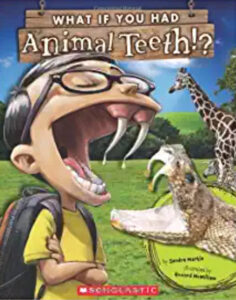 Sandra Markle’s What If texts are a series that seems specifically designed for an exploration of structure and function. Illustrated with an interesting mash-up of photographs and illustrations, the text explores how animal structures enable the animals to perform specific functions. The text then explores what it would mean if a human had similar structures and what that would mean for our ability to function differently. The series includes:
Sandra Markle’s What If texts are a series that seems specifically designed for an exploration of structure and function. Illustrated with an interesting mash-up of photographs and illustrations, the text explores how animal structures enable the animals to perform specific functions. The text then explores what it would mean if a human had similar structures and what that would mean for our ability to function differently. The series includes:
- What If You Had Animal Feet?
- What If You Had Animal Hair?
- What If You Had Animal Teeth?
- What If You Had An Animal Nose?
- What If You Had Animal Eyes?
- What If You Had Animal Ears?
- What If You Had Animal Scales?
- What If You Had An Animal Tail?
- What If You Had T-Rex Teeth and Other Dinosaur Parts?
- What I You Had An Animal Tongue?
- What If You Could Spy Like A Narwhal?
- What If You Could Sniff Like a Shark
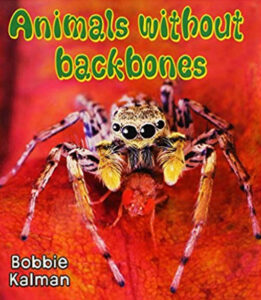 Bobbie Kalman is another series writer whose texts work well for an exploration of structure and function. Animals Without Backbones dives into the world of invertebrates including insects, spiders, worms, snails, and ocean animals and how their varied structures support their survival. How and Why Do Animals Move emphasizes the function of movement and discusses how different animal structures enable their modes of transportation. The detailed text and photographs in all of Kalman’s books make finding the links between structure and function accessible for all students.
Bobbie Kalman is another series writer whose texts work well for an exploration of structure and function. Animals Without Backbones dives into the world of invertebrates including insects, spiders, worms, snails, and ocean animals and how their varied structures support their survival. How and Why Do Animals Move emphasizes the function of movement and discusses how different animal structures enable their modes of transportation. The detailed text and photographs in all of Kalman’s books make finding the links between structure and function accessible for all students.
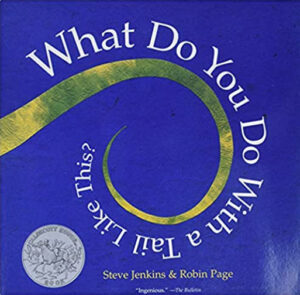 What Do You Do With a Tail Like That? by Steve Jenkins is one of my favorites for structure and function discussions because of the way the book itself is structured! The text discusses the function of different animal noses, ears, eyes, etc. by first presenting a page of differently structured animal parts and then sharing how those parts help each specific animal to survive. Having students predict the animals the structures are a part of and the functions made possible by those structures gives students the opportunity to really think about what animals need to survive and how different structures are beneficial for different animals.
What Do You Do With a Tail Like That? by Steve Jenkins is one of my favorites for structure and function discussions because of the way the book itself is structured! The text discusses the function of different animal noses, ears, eyes, etc. by first presenting a page of differently structured animal parts and then sharing how those parts help each specific animal to survive. Having students predict the animals the structures are a part of and the functions made possible by those structures gives students the opportunity to really think about what animals need to survive and how different structures are beneficial for different animals.
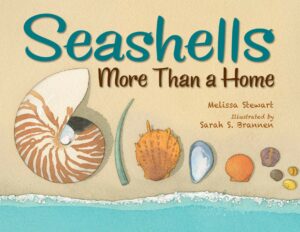 Seashells: More Than a Home by Melissa Stewart is laser-focused on how the structure of a seashell allows it to perform specific functions. In this texts, students will discover thirteen different shells and how their specialized structures help them to survive in the ocean.
Seashells: More Than a Home by Melissa Stewart is laser-focused on how the structure of a seashell allows it to perform specific functions. In this texts, students will discover thirteen different shells and how their specialized structures help them to survive in the ocean.
 Plants Can’t Sit Still by Rebecca Hirsch challenges the idea that plants are stationery by describing the many ways plants move to be successful growing and reproducing. Students can explore how each plants structure helps it to “move” in order to reproduce.
Plants Can’t Sit Still by Rebecca Hirsch challenges the idea that plants are stationery by describing the many ways plants move to be successful growing and reproducing. Students can explore how each plants structure helps it to “move” in order to reproduce.
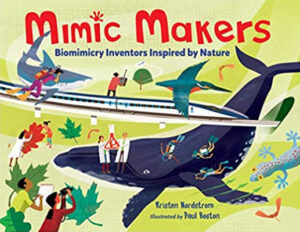 In Mimic Makers: Biomimicry Inventors Inspired By Nature by Kristen Nordstrom students learn about ten different inventors who looked to the natural world for inspiration to solve a problem. From trains designed after a bird’s beak to wind turbines designed after a whale’s flippers, this book explores the fascinating world of biomimicry inventions. In the context of structure and function, students are able to observe how engineers identify a desired function and then look to nature for structural inspiration!
In Mimic Makers: Biomimicry Inventors Inspired By Nature by Kristen Nordstrom students learn about ten different inventors who looked to the natural world for inspiration to solve a problem. From trains designed after a bird’s beak to wind turbines designed after a whale’s flippers, this book explores the fascinating world of biomimicry inventions. In the context of structure and function, students are able to observe how engineers identify a desired function and then look to nature for structural inspiration!
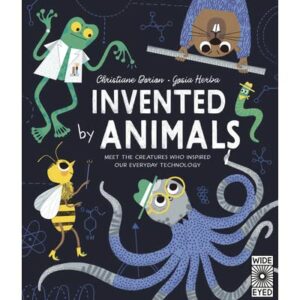 Invented by Animals by Christine Dorion is a similar text to Mimic Makers. It has amazing illustrations and thoroughly describes animals structures that have inspired human research. This book is packed with 40+ examples!
Invented by Animals by Christine Dorion is a similar text to Mimic Makers. It has amazing illustrations and thoroughly describes animals structures that have inspired human research. This book is packed with 40+ examples!
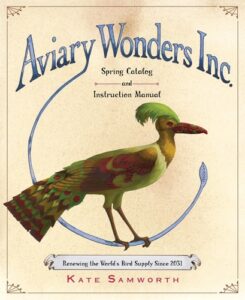 I recently discovered this book and now count it among my favorites for structure and function because the theme of the book revolves around that crosscutting concept. Students are invited to “order” bird parts from a catalog to create their very own bird. As they browse the catalog, students are introduced to bird parts that are structured to perform different functions. For example, do you want your bird to eat meat? Then you need to choose the beak of a carnivore because its structure is designed to perform that function! This book presents an opportunity for a fantastic connection to art by asking your students to draw what their bird will ultimately look like. Then ask students to label their drawings as if they were diagrams that detail what function each part will allow the bird to perform and why the structure of each part enables that function.
I recently discovered this book and now count it among my favorites for structure and function because the theme of the book revolves around that crosscutting concept. Students are invited to “order” bird parts from a catalog to create their very own bird. As they browse the catalog, students are introduced to bird parts that are structured to perform different functions. For example, do you want your bird to eat meat? Then you need to choose the beak of a carnivore because its structure is designed to perform that function! This book presents an opportunity for a fantastic connection to art by asking your students to draw what their bird will ultimately look like. Then ask students to label their drawings as if they were diagrams that detail what function each part will allow the bird to perform and why the structure of each part enables that function.
If you are looking for more structure and function texts, look up books by Steve Jenkins, Robin Page, Sandra Markle, and Sara Levine. Many of their texts have a structure and function focus – with the addition of colorful and compelling illustrations, you can’t go wrong!
If you are a StarrMatica Texts: Science Your Way subscriber, you can check out the texts below that align with an exploration of structure and function. Remember, each 1st – 5th grade text has multiple reading levels so all of your students can read the same content independently.
- K-2 Engineering: Sporty Shapes; The Importance of Shapes
- Kindergarten: Keeping Cool in the Sun; Stay in the Shade
- First grade: All Types of Bird Beaks; Just Like Animals; Shadows Everywhere; Shadow Puppets; Transparent, Opaque, and Translucent
- Second grade: From This to That; From Trash to Treasure; Built to Last; Materials Matter; Seeds Everywhere!; Powerful Pollinators!
- Third grade: Amazing Amazon Animals; Surviving and Thriving in the Amazon Rainforest; Island Lizards and a Leaf Blower; Lizard Adaptations; A Little Help Surviving; Amazing Adaptations; Amazing Animal Adaptations
- Fourth grade: Powerful Plants; Plant Power; The Flight of a Penguin; Penguin Launch Countdown; Bees and Ants Smell to Survive; Powerful Pheromones
Not a subscriber? Click here for a free trial to access the texts above.
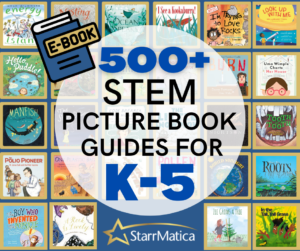 And if you are looking for additional picture books for your science classroom, check out the Perfect Picture Book Pairing Series that includes one-page guides with activities and discussion questions for hundreds of STEM-themed picture books aligned to every NGSS performance expectation!
And if you are looking for additional picture books for your science classroom, check out the Perfect Picture Book Pairing Series that includes one-page guides with activities and discussion questions for hundreds of STEM-themed picture books aligned to every NGSS performance expectation!
CLICK HERE TO PREVIEW THE PERFECT PICTURE BOOK PAIRING EBOOKS
Be sure to check out the other posts in this series to discover picture books to highlight each of the seven crosscutting concepts in the NGSS!
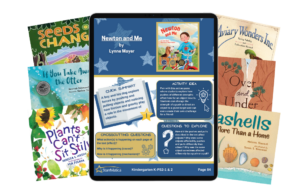
Want to save even more time with lesson ideas for 35 picture books that you can use to highlight all seven crosscutting concepts?
Enter your information below to receive your complimentary picture book guides including activity ideas, science questions, and crosscutting concept questions!

